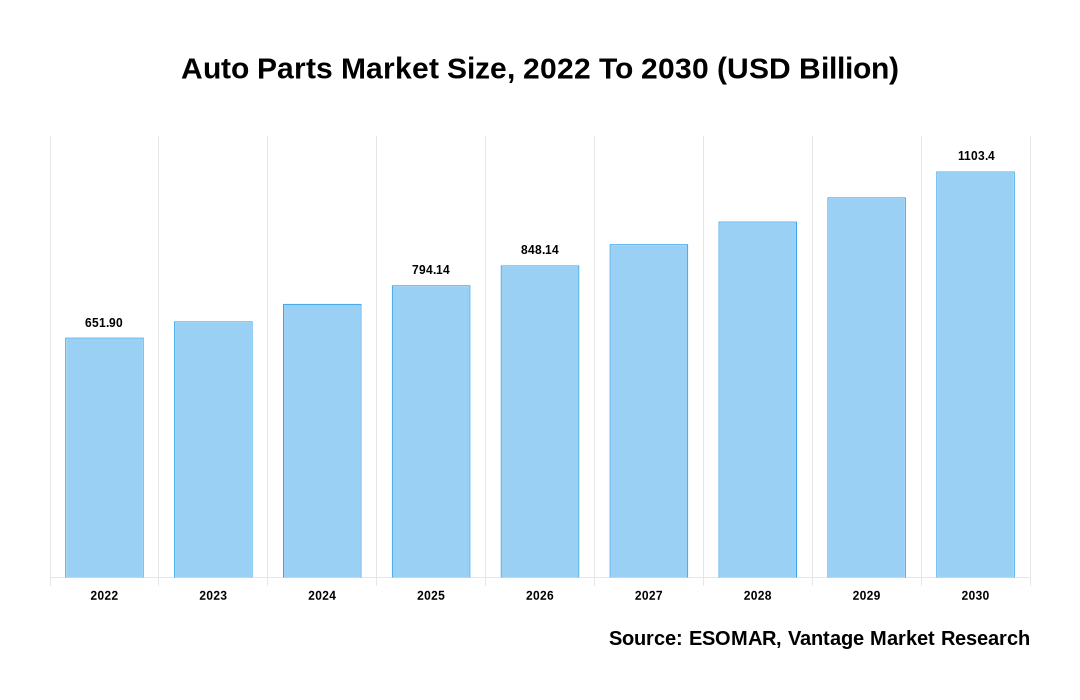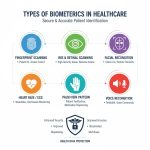Global Auto Parts Market
As stated in our extensive report; the Global Auto Parts Market accounted for USD 651.9 Billion in 2022 and is projected to reach a value of USD 1103.4 Billion by 2030.
The Auto Parts market has experienced significant growth as the automotive industry continues to evolve and expand. This growth can be attributed to increased vehicle production, technological advancements, changing consumer trends, and a growing aftermarket sector. Consumer trends and preferences also play a crucial role in the growth of the Auto Parts market. Consumers are increasingly prioritizing vehicle customization and performance enhancements, which has led to a surge in the demand for aftermarket Auto Parts.
Furthermore, vehicle customization and modification are becoming increasingly popular among auto enthusiasts, which is driving demand for performance-oriented components, including suspension upgrades, exhaust systems, and engine upgrades. Furthermore, consumers are seeking high-quality and reliable replacement parts as an alternative to expensive original equipment manufacturer (OEM) parts, contributing to the expansion of the aftermarket sector.
Click To Get a Free Sample On the Research Study

Moreover, the growth of the Auto Parts market can also be attributed to the increasing number of vehicles on the road. As the global vehicle fleet expands, the demand for replacement parts and maintenance services naturally follows suit. As vehicles age, their components wear out or become damaged, necessitating the replacement of various parts such as brakes, tires, filters, and batteries. This ongoing demand for replacement parts provides a steady revenue stream for the Auto Parts industry.
Key Factors Influencing Global Auto Parts Market Growth
The growth of the global Auto Parts market can be attributable to the following:
- The number of vehicles on the road constantly grows, especially in emerging markets. This trend generates a continuous demand for Auto Parts, as vehicles require regular maintenance and replacement of worn-out components.
- The advancements in automotive technology have led to the development of more complex and sophisticated parts. This has created a market for specialized Auto Parts, such as electronic components, sensors, and advanced safety systems.
- The rise of e-commerce has revolutionized the way Auto Parts are bought and sold. The emergence of online platforms has facilitated consumers’ search for and acquisition of necessary parts, hence augmenting the market’s overall expansion.
- The aftermarket segment of the Auto Parts market, which includes replacement parts and accessories, has been experiencing significant growth. This is fuelled by factors such as DIY repairs, customization trends, and the need for cost-effective alternatives to dealership repairs.
- The Auto Parts market has benefited from globalization and trade liberalization, as it has expanded supply chains and increased access to a broader range of parts at competitive prices.
- The availability of high-quality Auto Parts and the significance of routine vehicle maintenance are becoming more widely recognized by consumers. This has increased demand for genuine and reliable parts, creating opportunities for established market players.
Asia Pacific Region to Express the Largest Market Growth
Asia Pacific is accounted to have the most significant market growth in 2022. As the middle-class population expands and disposable incomes rise, more people can afford cars, leading to a surge in vehicle sales. This growing demand for automobiles has subsequently increased the demand for Auto Parts in this region. As vehicles age or require repairs, replacing parts and accessories becomes crucial. This has created a lucrative market for Auto Parts manufacturers and suppliers as they strive to cater to the rising needs of consumers.
Furthermore, the automotive industry in Asia Pacific is undergoing rapid development and technological advancements. As car manufacturers introduce new models with advanced features and technologies, the demand for specialized Auto Parts grows. This includes components related to electric vehicles, autonomous driving systems, and connected car technologies. With the region’s emphasis on sustainable transportation and reducing carbon emissions, the demand for environmentally friendly Auto Parts is also rising. This includes parts for hybrid and electric vehicles as governments and consumers shift towards more eco-friendly transportation options.
Conclusion
Overall, the Auto Parts market has experienced remarkable growth due to multiple factors, including increased vehicle sales, technological advancements, the rising demand for aftermarket products, and the growth of e-commerce. The need for sophisticated car parts is anticipated to grow as the automotive sector develops, posing opportunities for OEM and aftermarket providers. The market for Auto Parts will keep expanding owing to the rise of electric vehicles and the incorporation of cutting-edge technologies into cars.
Some of the key players in the Global Auto Parts Market include Robert Bosch GmbH (Germany), DENSO Corporation (Japan), Continental AG (Germany), ZF (Germany), Friedrichshafen AG (Germany), Hyundai Motor Group (South Korea), Aisin Corporation (Japan), Magna International Inc. (Canada), Valeo (France), Lear Corporation (U.S.) and others.
![[Market Research Reports] – Research Google News Blog | VMR.Biz](https://www.vmr.biz/wp-content/uploads/2022/12/logo-removebg-preview.png)











